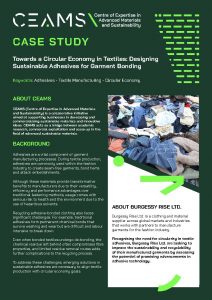CEAMS (Centre of Expertise in Advanced Materials and Sustainability) is a collaborative initiative aimed at supporting businesses in developing and commercialising sustainable materials and innovative ideas. CEAMS acts as a bridge between academic research, commercial exploitation and scale-up in the field of advanced sustainable materials.
Background
Adhesives are a vital component of garment manufacturing processes. During textile production, adhesives are commonly used within the fashion industry to create seam-free garments, bond hems and attach embellishments.
Although these materials provide transformative benefits to manufacturers due to their versatility, efficiency and performance advantages over traditional fastening methods, usage comes with serious risk to health and the environment due to the use of hazardous solvents.
Recycling adhesive-bonded clothing also faces significant challenges. For example, traditional adhesives form permanent chemical bonds that survive washing and wear but are difficult and labour intensive to break down.
Even when bonded textiles undergo de-bonding, the chemical residue left behind often compromises fibre properties, and limited residue removal routes adds further complications to the recycling process.
To address these challenges, emerging solutions in sustainable adhesives are necessary to align textile production with circular economy goals.
Burgessy Rise Ltd. is a clothing and material supplier across global markets and industries that works with partners to manufacture garments for the fashion industry.
Recognising the need for circularity in textile adhesives, Burgessy Rise Ltd. are looking to improve the sustainability and recyclability of their manufactured garments by assessing the potential of promising advancements in adhesive technology.
Project
CEAMS Application Scientists from the Henry Royce Institute conducted a 9-month investigation to identify whether sustainable adhesive formulations could be developed and applied to textile applications.
The project sought to develop a novel water-based adhesive with physical switchability as an alternative to conventional solvent-based adhesives. Physical switchability would enable the adhesive to reversibly transition between high and low adhesion states in response to stimuli, enabling on-demand debonding without altering the adhesive’s chemical composition.
Ideally, the adhesives would be compatible with relevant fabric substrates for effective coating, and sit within a sustainable, low-hazard solvent system.
Synthesised adhesives were tested in-house and assessed by mechanical testing, microscopy, and coating performance, with additional studies into reversibility and stability.
Results
A new adhesive system was developed to support sustainable garment applications. The adhesive system displayed reversible adhesion, allowing separation in response to stimuli when needed. In addition, the adhesives demonstrated high adhesive strength on polycotton fabrics, maintaining excellent mechanical performance during handling and use.
A series of targeted recommendations were also proposed to guide future development. These include optimising scale-up processes and improving the adhesive system’s stability in laundry detergent to ensure adhesion is maintained in neutral conditions.
Impact
The project successfully developed a controllable, switchable adhesive system designed to address key sustainability challenges facing the textile industry.
Through the CEAMS programme, Application Scientists from the Henry Royce Institute supported Burgessy Rise Ltd. in their transition toward recyclable garment production, advancing a promising adhesive technology that brings the company one step closer to achieving its circular economy goals.
CEAMS recognises textiles as a major opportunity for sustainable innovation, with a particular focus on reducing waste and improving end-of-life recycling. This collaboration puts advanced materials innovation at the centre of sustainable transformation across the sector.
"The rigorous research experience, made possible through the collaboration facilitated by CEAMS and the involvement of world-class scientists, yielded findings that are not only empirically robust but have also positioned us to drive impactful innovation and enable real-world application. This project would not have been possible without CEAMS’ initiative. We look forward to the next phase of our collaboration."
Burgessy Rise Ltd.




